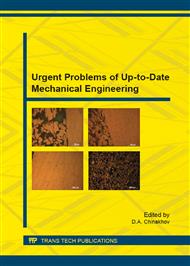p.429
p.434
p.439
p.445
p.449
p.456
p.461
p.464
p.469
Mathematical Model of Thermal Physics of the Dual-Cycle Cooling System of the Tool for Pieces Nanostructuring Burnishing
Abstract:
The article considers the problems of the mathematical modeling of thermal physics of the tool for nanostructuring burnishing. Physical and equivalent heat diagram of the system are developed. On the basis of the equivalent heat transfer diagram, the equivalent circuit and the system of equations of the mathematical model are created. The dependence of the tool indenter tip temperature on cooling system thermal parameters is obtained. The comparison of efficiency of heat removal from the tool indenter when using the developed two-circuit cooling system and the system supplying lubricant cooling liquid through the lathe centre spindle, as well as when applying nanostructuring burnishing without cooling is carried out.
Info:
Periodical:
Pages:
449-455
Citation:
Online since:
June 2015
Authors:
Price:
Сopyright:
© 2015 Trans Tech Publications Ltd. All Rights Reserved
Share:
Citation:


